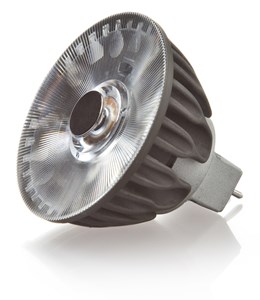May 18 2013
Removing barriers to the widespread adoption of LED lighting, Soraa announced today 230V GU10 and 100V E11 versions of its new perfect spectrum SORAA VIVID 2 and PREMIUM 2 LED MR16 lamps—the first ultra-efficient replacements for 65-watt and 75-watt halogen lamps.
 SORAA PREMIUM 2 & VIVID 2 LED MR16 Lamp
SORAA PREMIUM 2 & VIVID 2 LED MR16 Lamp
A technological breakthrough made possible by Soraa's world-record performance gallium-nitride on gallium-nitride (GaN on GaN™) LEDs, the new SORAA LED MR16 lamps deliver the industry's highest light output, while rendering vivid colors, richer reds and whiter whites, transforming ordinary lighting in any space into extraordinarily vibrant, brilliant and energy efficient lighting. Today's announcement comes on the heels of Soraa's new lamp line availability announcement for the North American market.
"The SORAA VIVID 2 and PREMIUM 2 lamp lines represent a tipping point in the widespread adoption of LED MR16 lamps — we now have 65-watt to 75-watt equivalent lamps that produce full visible spectrum light and consume 80% to 85% less energy," said Dr. Tom Caulfield, President and COO of Soraa. "And what's amazing is that we have just scratched the surface in terms of performance gains from our GaN on GaN LED technology. Look out halogens — your days are numbered."
Most LED lamps available today are based on LEDs made by depositing GaN on foreign substrates like sapphire, silicon carbide or silicon. Consequently, these LEDs have high crystal defect densities that limit the amount of current densities they can handle, thereby limiting the amount of light they emit per unit area. These high defect densities also constrain the LEDs to much lower temperatures in order to operate reliably. Both these limitations are amplified when these LEDs are used in a small form factor like an MR16 lamp, which is frequently installed in constrained or enclosed fixtures, and is used in applications that require very high light output. The lamps that use these LEDs have to make compensating design choices like using multiple LED light sources to generate the required amount of light, and active cooling mechanisms to keep the LEDs within their operating temperature range.
In contrast, the SORAA VIVID 2 and PREMIUM 2 lamps' GaN on GaN LED technology leverages the 1000x lower crystal defect density advantage of the native substrate, thus emitting substantially more light and allowing reliable operation at much higher temperatures. This enables a very simple and robust MR16 lamp design that uses a single LED light source and a simple heatsink, while producing 65W to 75W halogen equivalent light output and operating reliably at lamp temperatures of up to 120°C, a requirement for use in the most constrained fixtures.
"I believe the SORAA VIVID 2 and PREMIUM 2 lamp lines will have a profound effect on lighting design — smaller-form-factor, high-output LED MR16 lamps will now replace larger lamp types like PARs," added Dr. Caulfield.
The SORAA VIVID 2 LED MR16 lamp has a CRI of 95 and R9 of 95 and is available in a complete suite of beam angles, color temperatures and lumen outputs; and the SORAA PREMIUM 2 LED MR16 lamp has a CRI of 80 and is available in multiple beam angles and color temperatures.
Experience the SORAA VIVID 2 and PREMIUM 2 LED MR16 lamps at Soraa's booth (#P72) at The ARC Show in London, UK on May 19-21. For more information on all of Soraa's LED MR16 lamp lines, visit web site.